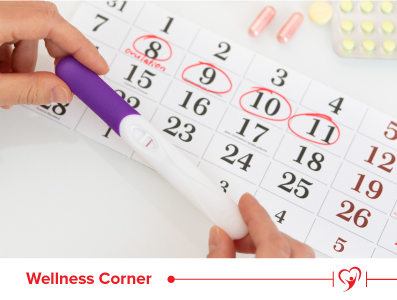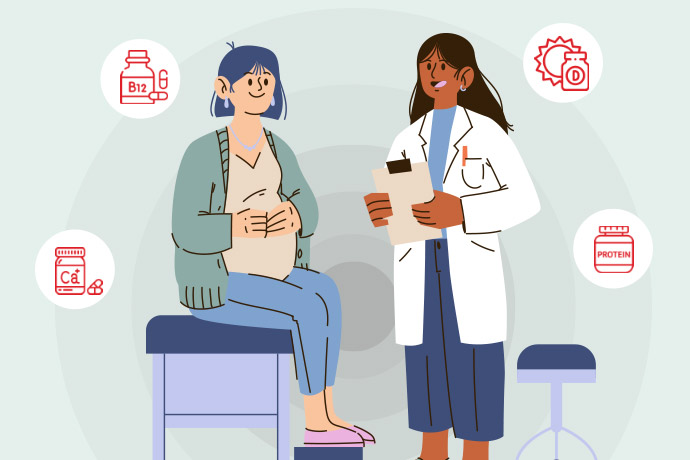

Here are the results based on the information you provided:
It’s likely that you’ll next ovulate (release an egg) between these dates
Sperm can last up to 7 days and the egg for 24 hours. Having regular sex before, during and after these dates increases your chance of pregnancy.
Your next period
Take a pregnancy test on
Your estimated due date
Ovulation Calculator – Estimate Your Fertile Dates

The ovulation calculator estimates the most probable ovulation/fertile window as well as other related dates. The estimates are based on a woman’s last period date. This ovulation calculator provides an estimate of your fertile window and is not a guarantee of pregnancy or of birth control. Talk to your doctor or nurse to plan for pregnancy and find birth control that works for you.
How long is my cycle?
A menstrual cycle begins on the first day of your monthly cycle or period and ends on the day before your next period. Although the average length of a menstrual cycle is 28 days, the same varies from woman to woman. Women may experience shorter and longer cycles of 23 to 35 days, and this is considered normal unless one is suffering from underlying health conditions.
What is Ovulation?
Ovulation is when your ovaries release an egg each month. It is an important phase in a woman’s menstrual cycle as it is during this phase that the ovary releases an egg for fertilisation. This usually happens about two weeks before your period starts. Therefore, the chances of getting pregnant are highest five days before and on the day of ovulation.
If you are trying to get pregnant, knowing the dates when you are more fertile can help you conceive a child. Instead of predicting your ovulation date, you can use an ovulation calculator to know your fertile window in the coming months. This can help to plan a pregnancy or avoid an unwanted one.
What are the signs of ovulation?
Some common signs of ovulation are —
• Pelvic pain
Many women experience mild pain or sharp cramps on one side of the pelvis or in the lower abdominal area. The pain usually lasts for a short period.
• Vaginal bleeding
Ovulation can also cause light vaginal bleeding or discharge. This is called ovulation spotting. However, the same is usually mild and lasts a couple of days only.
• Change in basal body temperature
BBT, or Basal Body Temperature, is the body temperature right after waking up in the morning. The temperature is low in the follicular phase, i.e., before ovulation. Once you ovulate, the temperature rises.
Therefore, an increase in BBT is a sign that ovulation has happened.
• Change in cervical mucous
The body produces more oestrogen during ovulation and this causes changes in cervical mucous. If your cervical mucous increases in volume and becomes clear and stretchy, you will know that ovulation has taken place.
• Breast tenderness
Owing to hormonal changes before and after ovulation, you may experience breast tenderness or sore nipples after ovulation.
• Other signs
Some other signs of ovulation are headaches, nausea, heightened sense of smell, bloating, and increased sex drive.
Common methods for ovulation prediction
If you are trying to get pregnant, knowing the day of ovulation can increase your chances of conceiving a child. Therefore, in addition to ovulation calculator, some common methods for ovulation prediction are —
Calendar method
This method uses the length of a menstrual cycle and the date of your last period to predict the ovulation date. If your periods are regular, you are likely to ovulate 14 days before your next period.
Basal body temperature monitoring method
Your basal body temperature changes throughout the menstrual cycle. However, the temperature is usually lower before ovulation (between 97.6°F and 98.6°F) and higher after ovulation. Therefore, you are most fertile when your BBT is the lowest. This is a common method for ovulation prediction.
Ovulation predictor kits
The ovulation predictor kits are used to measure a type of reproductive hormone called the Luteinizing Hormone (LH). This hormone plays a vital role in stimulating the production of oestrogen in the body. The LH levels spike dramatically before the day of ovulation and this causes the body to ovulate. Ovulation predictor kits are used to measure LH levels in the body. These are like pregnancy test kits, and they show a particular colour when the hormone levels are high.
In addition to these, tracking your menstrual cycle and noticing obvious changes in the body, such as pelvic pain and thickened cervical mucous, can also help predict ovulation.
How do I use the ovulation calculator?
An ovulation calculator can help you estimate your fertile window and increase your chances of getting pregnant. Although different ovulation calculators work differently, they basically need the same information.
Therefore, to know your next ovulation date, you must enter the following information:
• The start date of your last period
• The average length of your menstrual cycle
Once you enter and submit the information, the calculator shows an estimate of your most fertile days. Since your menstrual cycle may differ every month, you can use the calculator after you get your period to know when you may be ovulating. Knowing your most fertile days can help you get pregnant or avoid an unwanted pregnancy.
How do we calculate our fertile window?
When you are looking to calculate your fertile window to get pregnant or to avoid pregnancy, you can simply use an online ovulation calculator. However, to use the calculator and to get accurate or near-accurate results, you must enter the required data correctly. The calculator will ask you to enter the first day of your last period and the number of days in your menstrual cycle. With this information, the calculator will estimate your next ovulation date.
NOTE : This tool provides approximate dates only and assumes a regular menstrual cycle. The timing of your fertile window can be unpredictable, even if your cycles are usually regular.
What if my periods are irregular?
Irregular periods can make it challenging for you to track your ovulation or fertile window. In this case, you can use the ovulation test kits. Look out for the signs of ovulation and use the test kit when you notice one or more signs, such as pain on one side of the pelvis and light vaginal bleeding. You can also monitor your basal body temperature often to understand if you are nearing ovulation or have ovulated already. If your BBT is lower than usual, you are about to ovulate, and this is the best time to conceive. Once you ovulate, you will notice an increase in your BBT.
When is the best time to conceive?
The best time to conceive is 5 days before ovulation and the day you ovulate. Therefore, you get a 6-day window every month to get pregnant. The average length of a menstrual cycle is 28 days. If your periods are normal and regular, ovulation will happen between 13 and 15 days. You can use the ovulation calculator for accurate or near-accurate results and plan your pregnancy accordingly. Also, use ovulation test kits around your ovulation date to be doubly sure about the same.
Tips for getting pregnant
If you are trying to conceive a child, the following tips for getting pregnant can help —
• Know your menstrual cycle
Understand your menstrual cycle and be aware of the signs of ovulation. If you notice signs, such as pelvic pain, cervical mucous, bloating and breast tenderness, it is likely that you are ovulating. You can also use an ovulation calculator or ovulation test kits to know if you are fertile. Having intercourse during this time can increase your chances of conceiving a child.
• Take prenatal vitamins
Studies have shown that prenatal vitamins can increase your chances of getting pregnant. Therefore, consult a gynaecologist and start taking the vitamins.
• Keep lying in bed right after intercourse
Do not get up from the bed right after intercourse. Keep lying for about 10 to 15 minutes and raise your feet up in the air to increase your chances of getting pregnant.
• Follow healthy lifestyle habits
Concentrate on consuming a nutritious diet and maintain a healthy body weight. Also, follow a light workout routine and get restful sleep at night. Do not overdo with exercise, though, as it may cause you not to ovulate. Most importantly, stay away from alcohol and tobacco.
• Keep stress at bay
If you are stressed about starting a family, take a few deep breaths and relax. Look for ways to ease your stress levels as excessive stress can harm your body and alleviate your chances of pregnancy. Meditation is a good way to ease stress and enhance your physical and emotional well-being.
Read Latest Wellness Blogs
Frequently Asked Questions
1. How accurate is the ovulation calculator?
If your menstrual cycles are regular, i.e., the length of your cycles is the same every month, the ovulation calculator can calculate your fertile days accurately. However, the calculator may not show precise results for women with irregular monthly cycles.
2. Is ovulation only on one day?
Yes, ovulation happens on one day but you have a 6-day window every month to get pregnant. This window starts 5 days before ovulation plus the ovulation day. Sperm can live inside a woman’s body for a maximum of 5 days. However, you can also get pregnant after ovulation if you have intercourse within 12-24 hours. If you miss one fertile window, you cannot get pregnant until your next menstrual cycle.
3. Does ovulation cause bleeding?
Ovulation can cause light bleeding in many due to changes in oestrogen and progesterone levels in the body. This is also called ovulation spotting, and it happens outside the regular periods. The bleeding is very light and can happen between 11 and 21 days after the first day of your period. Ovulation depends on the length of your menstrual cycle. If the length of your menstrual cycle changes by 3 to 4 days every month, you will notice ovulation spotting on a different day every month.
4. Can conceiving at certain times increase my chances of having twins?
No, there's no way to increase the chances of having twinis. It may be more likely to happen for you if you're having fertility treatment, are over 35, or if twins run in your family.
5. Can you still get pregnant when you are not ovulating?
You can get pregnant only when the sperm fertilises your egg. Therefore, ovulation is the best time to conceive a child. However, there are some chances of getting pregnant a week after your period. Sperm can survive in your body for about 5 days, so if you have intercourse after 7 days of your period and you ovulate within the next 5 days, you can get pregnant. However, it is highly unlikely to get pregnant when you are having periods or after the fertile window of 6 days.
Published on 01 February 2024
Last updated: Feb 01, 2024
References:
- https://www.healthline.com/health/womens-health/ovulation-symptoms#ovulation-signs
- https://www.thebump.com/a/ovulation-symptoms-signs-of-ovulation
- https://www.mayoclinic.org/healthy-lifestyle/getting-pregnant/expert-answers/ovulation-signs/faq-20058000
- https://uscfertility.org/3-ways-test-ovulation-home/
- https://www.winfertility.com/blog/five-techniques-monitor-predict-ovulation/
- https://www.motherhoodindia.com/ovulation-calculator/#:~:text=An%20ovulation%20calculator%20can%20help,as%20a%20method%20of%20contraception
- https://www.womenshealth.gov/ovulation-calculator
- https://www.tommys.org/pregnancy-information/calculators-tools-resources/ovulation-calculator
- https://www.whattoexpect.com/ovulation-calculator/#tips
- https://www.healthline.com/health/pregnancy/ovulation-bleeding#timeline
- https://knix.com/blogs/resources/can-you-get-pregnant-when-not-ovulating
Disclaimer: This blog provides general information and discussions about health and related subjects. The information and other content provided in this blog, website or in any linked materials are not intended and should not be considered, or used as a substitute for, medical advice, diagnosis or treatment. Kindly contact your Doctor before starting a new medicine or health regime.
































 Car Insurance
Car Insurance  Bike/Two Wheeler Insurance
Bike/Two Wheeler Insurance  Health Insurance
Health Insurance  Pet Insurance
Pet Insurance  Travel Insurance
Travel Insurance  Home Insurance
Home Insurance  Cyber Insurance
Cyber Insurance  Third Party Vehicle Ins.
Third Party Vehicle Ins.  Tractor Insurance
Tractor Insurance  Goods Carrying Vehicle Ins.
Goods Carrying Vehicle Ins.  Passenger Carrying Vehicle Ins.
Passenger Carrying Vehicle Ins.  Compulsory Personal Accident Insurance
Compulsory Personal Accident Insurance  Travel Insurance
Travel Insurance  Rural
Rural  Critical illness Insurance
Critical illness Insurance